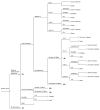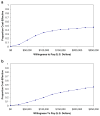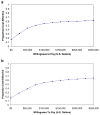Cost-effectiveness of multifaceted evidence implementation programs for the prevention of glucocorticoid-induced osteoporosis
- PMID: 19937227
- PMCID: PMC3815619
- DOI: 10.1007/s00198-009-1114-8
Cost-effectiveness of multifaceted evidence implementation programs for the prevention of glucocorticoid-induced osteoporosis
Abstract
Summary: Using a computer simulation model, we determined that an intervention aimed at improving the management of glucocorticoid-induced osteoporosis is likely to be cost-effective to third-party health insurers only if it focuses on individuals with very high fracture risk and the proportion of prescriptions for generic bisphosphonates increases substantially.
Introduction: The purpose of this study is to determine whether an evidence implementation program (intervention) focused on increasing appropriate management of glucocorticoid-induced osteoporosis (GIOP) might be cost-effective compared with current practice (no intervention) from the perspective of a third-party health insurer.
Methods: We developed a Markov microsimulation model to determine the cost-effectiveness of the intervention. The hypothetical patient cohort was of current chronic glucocorticoid users 50-65 years old and 70% female. Model parameters were derived from published literature, and sensitivity analyses were performed.
Results: The intervention resulted in incremental cost-effectiveness ratios (ICERs) of $298,000 per quality adjusted life year (QALY) and $206,000 per hip fracture averted. If the cohort's baseline risk of fracture was increased by 50% (10-year cumulative incidence of hip fracture of 14%), the ICERs improved significantly: $105,000 per QALY and $137,000 per hip fracture averted. The ICERs improved significantly if the proportion of prescriptions for generic bisphosphonates was increased to 75%, with $113,000 per QALY and $77,900 per hip fracture averted.
Conclusions: Evidence implementation programs for the management of GIOP are likely to be cost-effective to third-party health insurers only if they are targeted at individuals with a very high risk of fracture and the proportion of prescriptions for less expensive generic bisphosphonates increases substantially.
Conflict of interest statement
Figures



Similar articles
-
Cost-effectiveness of bisphosphonates for prevention of fracture related to glucocorticoid-induced osteoporosis in Malaysia.Int J Rheum Dis. 2018 Mar;21(3):647-655. doi: 10.1111/1756-185X.13206. Epub 2017 Nov 3. Int J Rheum Dis. 2018. PMID: 29105349
-
The cost effectiveness of teriparatide as a first-line treatment for glucocorticoid-induced and postmenopausal osteoporosis patients in Sweden.BMC Musculoskelet Disord. 2012 Oct 30;13:213. doi: 10.1186/1471-2474-13-213. BMC Musculoskelet Disord. 2012. PMID: 23110626 Free PMC article.
-
Economic evaluation of a population-based osteoporosis intervention for outpatients with non-traumatic non-hip fractures: the "Catch a Break" 1i [type C] FLS.Osteoporos Int. 2017 Jun;28(6):1965-1977. doi: 10.1007/s00198-017-3986-3. Epub 2017 Mar 9. Osteoporos Int. 2017. PMID: 28275838 Free PMC article.
-
Bisphosphonates in the treatment of glucocorticoid-induced osteoporosis: pros.Endocrine. 2015 Aug;49(3):620-7. doi: 10.1007/s12020-014-0506-5. Epub 2015 Feb 4. Endocrine. 2015. PMID: 25649760 Review.
-
Cost Effectiveness Analyses of Interventions for Osteoporosis in Men: A Systematic Literature Review.Pharmacoeconomics. 2023 Apr;41(4):363-391. doi: 10.1007/s40273-022-01239-2. Epub 2023 Feb 4. Pharmacoeconomics. 2023. PMID: 36738425 Free PMC article.
Cited by
-
Glucocorticoid-induced osteoporosis: 2019 concise clinical review.Osteoporos Int. 2019 Jun;30(6):1145-1156. doi: 10.1007/s00198-019-04906-x. Epub 2019 Feb 25. Osteoporos Int. 2019. PMID: 30805679 Review.
-
Prevention and Treatment of Glucocorticoid-Induced Osteoporosis in Adults: Consensus Recommendations From the Belgian Bone Club.Front Endocrinol (Lausanne). 2022 Jun 9;13:908727. doi: 10.3389/fendo.2022.908727. eCollection 2022. Front Endocrinol (Lausanne). 2022. PMID: 35757436 Free PMC article. Review.
-
A framework for the development of guidelines for the management of glucocorticoid-induced osteoporosis.Osteoporos Int. 2012 Sep;23(9):2257-76. doi: 10.1007/s00198-012-1958-1. Epub 2012 Mar 21. Osteoporos Int. 2012. PMID: 22434203
-
Cost-effectiveness of implementing guidelines for the treatment of glucocorticoid-induced osteoporosis in Japan.Osteoporos Int. 2019 Feb;30(2):299-310. doi: 10.1007/s00198-018-4798-9. Epub 2019 Jan 4. Osteoporos Int. 2019. PMID: 30610244
-
Oral bisphosphonates reduce the risk of clinical fractures in glucocorticoid-induced osteoporosis in clinical practice.Osteoporos Int. 2013 Jan;24(1):263-9. doi: 10.1007/s00198-012-2060-4. Epub 2012 Jun 27. Osteoporos Int. 2013. PMID: 22736069
References
-
- van Staa TP, Leufkens HG, Abenhaim L, Begaud B, Zhang B, Cooper C. Use of oral corticosteroids in the United Kingdom. QJM. 2000;93(2):105–111. - PubMed
-
- Mudano A, Allison J, Hill J, Rothermel T, Saag K. Variations in glucocorticoid induced osteoporosis prevention in a managed care cohort. J Rheumatol. 2001;28(6):1298–1305. - PubMed
-
- Curtis JR, Westfall AO, Allison J, Becker A, Melton ME, Freeman A, et al. Challenges in improving the quality of osteoporosis care for long-term glucocorticoid users: a prospective randomized trial. Arch Intern Med. 2007;167(6):591–596. - PubMed
-
- Kanis JA, Stevenson M, McCloskey EV, Davis S, Lloyd-Jones M. Glucocorticoid-induced osteoporosis: a systematic review and cost-utility analysis. Health Technol Assess. 2007;11(7):iii–iv. ix–xi, 1–231. - PubMed
MeSH terms
Substances
Grants and funding
LinkOut - more resources
Full Text Sources
Medical

